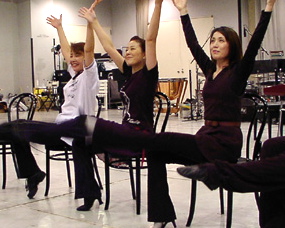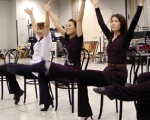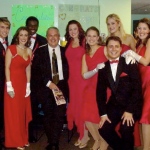by Ray Sikorski

Submitted photo of Eliot Fintushel in Flowers of Evil
SONOMA COUNTY, CA – So, there’s the pantomime. And the reciting of French poetry. And the weird instruments. And the Zen. This is what Eliot Fintushel embraces in his avant garde solo performances.
But even Fintushel has trouble squaring Zen Buddhism with live theater.
“The fundamental in meditation is that you get rid of all audience,” says Fintushel, 60. “But if you do that as a performer in theater, there’s another name for it. It’s called self-indulgence.”
Perhaps it’s the ying-yang opposition that holds the attraction for Fintushel – and his audiences. His most eyebrow-raising instrument is the Etherwave theremin, a machine that is played without touch. Instead, it reacts to the electromagnetic field projected by the musician. In his one act show, Flowers of Evil, Fintushel intersperses lines from Baudelaire’s poetry with simple, lovely melodies of Debussy, which he plays on the theremin.
“It seems so natural for a mime to play an instrument that you never touch,” he says, explaining that the instrument will respond not only to the movement of his body, but to the movement of bodies all around it.
“Just by how you stand or how you move, you absorb more or fewer electrons, and that changes the resonance and circuitry inside the instrument and makes the notes higher and lower, or louder and softer.
“If I breathe deeply, it will change the pitch. If I eat a big meal before I play, I have to tune it differently. If the audience leans forward all at once, it would change my tuning.”
And so there is this balance. Fintushel is a performer, but he has no background in traditional theater. He is a musician, but he never comes in contact with the instrument. His show is avant garde, but the audience seems to get it.
It wasn’t always that way. Before moving to his current home of Santa Rosa, California, Fintushel grew up in Rochester, New York. His father was a baker, then a machinist. His mother was a clerical worker. He had an uncle who taught a baking class at the high school.
“So being a schoolteacher was in my sights, but I could not imagine anything beyond that, and I had to be knocked around and have a lot of crazy misadventures before I began to see what it might mean to do something very different from those things.”
A New Year’s party after a week-long retreat at a Rochester Zen center gave him the epiphany he needed, and he’s devoted the rest of his life to performance and writing. Along with his one-man shows, Fintushel teaches mime, mask, and improvisational theater at the Santa Rosa Junior College, writes science fiction and essays, busks with his theremin in Santa Rosa’s Railroad Square, and travels to schools giving shows to children. He has given over 4,000 performances, and is currently working with Santa Rosa’s Imaginists Theatre Collective on a new production of Alfred Jarry’s Ubu Roi.
While Fintushel admits that his first one-man show, based on the Book of Revelation, may have alienated some audiences, his Baudelaire show seems to have struck a happy nerve. Audiences delight in the juxtaposition of Baudelaire’s poetry, the theremin music, and Fintushel’s sparse but focused use of props.
And, of course, there’s the performance itself. “It’s a matter of sweat and blood,” he says of the connection between Zen and theater. The passion that’s required to figure out a Zen koan must also be apparent by actors on stage. Emotional energy is the biggest requirement.
“I’m really an introvert, I’m a very shy guy, but on stage I can be anything. I can be a tornado, I can be a lion, I can be the entire population of the northern hemisphere… On stage there’s no holds barred, the sky’s the limit. Not even the sky.”
Information on Eliot Fintushel’s live performances can be found at www.fintushel.com and www.fintushel.com/fintushel.htm.
- Submitted photo of Eliot Fintushel in Flowers of Evil
- Submitted photo of Eliot Fintushel in Flowers of Evil
- Submitted Photo of Eliot Fintushel in Flowers of Evil
- Submitted Photo of Eliot Fintushel in Flowers of Evil
∞
Ray Sikorski wrote and directed his first one-act play in 1988, and his second 20 years later. He is a freelance writer based in Bozeman, Montana.











